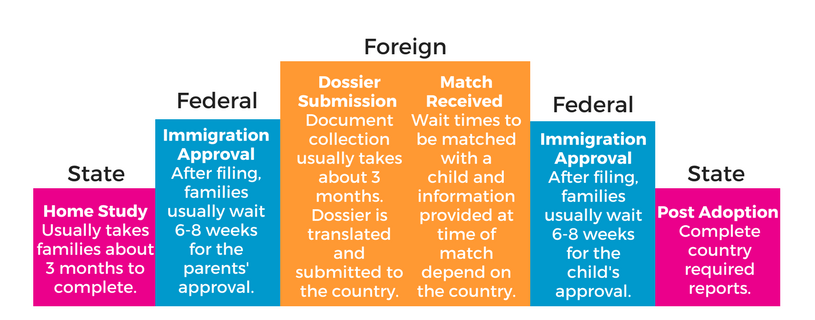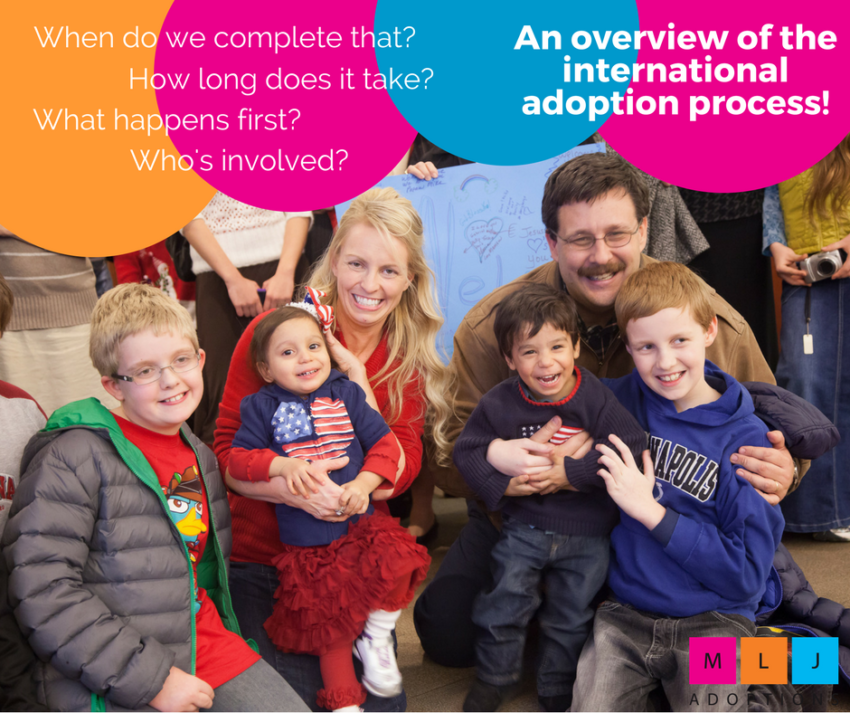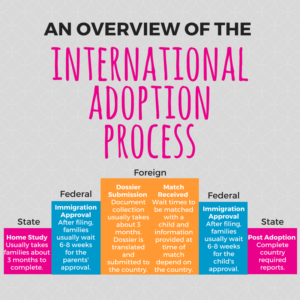International adoption involves state, federal and foreign entities including social workers, adoption professionals, government officials, judges, attorneys, caregivers and immigration workers. Before you get overwhelmed because, “Man, that’s a lot of people involved!” let’s walk through the process. This is a general overview, and each country program will differ, but hopefully you’ll gain an overall understanding of the process, which can be helpful.

Once your family decides which country you want to adopt from and selects an adoption agency, the first step is to complete a home study. The goal of the home study is to demonstrate that your family meets your state requirements for adopting, and that your family would be a good home to a child or children with specific characteristics – age, gender, needs, etc. Your home study must meet the state requirements from both your family’s home state and the state your adoption agency is based in. You may work with a home study agency different from your adoption agency, especially if your adoption agency isn’t in your state of residence. Most adoption agencies ask their families to work with a Hague Accredited Home Study Agency during the home study stage.
Once your home study is complete, it will be submitted with an immigration application to the United States Citizenship and Immigration Services (USCIS). This step is how the federal government approves families to adopt internationally. Once you submit this application, you can expect to wait six to eight weeks for approval, though it could take longer.
While you’re waiting on your immigration approval from the federal government, you may begin working on your dossier. The dossier is a portfolio of documents that is sent to the country that you’re adopting from. The dossier for each country differs, so you will want to pay close attention to what your adoption agency shares about dossier requirements. For most of MLJ Adoptions’ country programs, gathering dossier documents takes about three months. Families can collect documents while they’re waiting for their immigration approval. Once all the documents are obtained, notarized, apostilled and/or authenticated, and translated, your family’s dossier can be submitted to the foreign country. In some cases your dossier may be translated by MLJ’s in-country staff, but it may also be translated in the United States before it is sent.
After your family’s dossier has been submitted, the wait time to be matched with a child officially begins. The matching process is called a referral, and in most of MLJ Adoptions’ country programs, the referral will be made by a governmental entity in the foreign country. The wait time to receive a referral is dependent on the country that you’re adopting from, the age and characteristics of the child who you’re hoping to adopt, and the other families waiting to be matched. The amount of information given at the time of your referral is also dependent on the foreign country.
In order to bring your child home to the United States, there are U.S. immigration procedures that you must follow. This immigration application is child-specific, so it can only be completed after your family has accepted a referral. The U.S. Embassy in the country that your family is adopting from will be involved in the immigration processing, but their involvement will depend on your family’s case and the country.
Noticeably missing from this overview is travel. Each country varies greatly on how many trips are required, when a family is asked to travel, and how long they’ll need to remain in-country.
Even after your child has arrived home, there will be some final steps needed to complete your adoption process. Depending on your state, you may need complete the re-adoption process, which finalizes the adoption in your state. If your home study was completed by an agency in your state of residence, that same agency should be able to complete your post-adoption reports. These reports are required by the country you adopted from. After they’re completed, you will send them to your adoption agency who will send them to the country. Post-adoption reports are your child’s country of origin’s way of seeing that your child is adjusting well to their new family and that adoption is a good thing!
The first step in your international adoption journey is to decide on a country and adoption agency. If you have questions about getting started on an international adoption, contact us.


